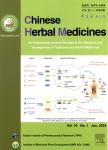Integrating systematic pharmacology-based strategy and experimental validation to explore mechanism of Tripterygium glycoside on cholangiocyte-related liver injury
Integrating systematic pharmacology-based strategy and experimental validation to explore mechanism of Tripterygium glycoside on cholangiocyte-related liver injury作者机构:School of Life SciencesBeijing University of Chinese MedicineBeijing 100029China Beijing Research Institute of Chinese MedicineBeijing University of Chinese MedicineBeijing 100029China
出 版 物:《Chinese Herbal Medicines》 (中草药(英文版))
年 卷 期:2022年第14卷第4期
页 面:563-575页
学科分类:1007[医学-药学(可授医学、理学学位)] 1006[医学-中西医结合] 10[医学] 100602[医学-中西医结合临床]
基 金:supported by grants from Beijing Nova Program of Science&Technology(Grant No.Z191100001119088 to XL) Beijing Municipal Science&Technology Commission(Grant No.7212174 to XL) National Natural Science Foundation of China(Grant No.82004045 to XL) Young Talents Promotion Project of China Association of Traditional Chinese Medicine(Grant No.2020-QNRC2-01 to XL) Innovation Team and Talents Cultivation Program of National Administration of Traditional Chinese Medicine(Grant No.ZYYCXTD-C-202006 to XL)。
主 题:cell apoptosis cholangiocyte liver injury Tripterygium glycoside triptolide
摘 要:Objective:Tripterygium glycoside(TG)is widely used in clinical practice for its multiple bioactivities including anti-inflammatory and immunosuppressive effects.However,emerging studies have frequently reported TG-induced adverse reactions to multiple organs,especially liver.Here,this study aimed to investigate the mechanism of liver damage induced by TG and explore representative components to reflect TG hepatotoxicity.Methods:Network pharmacology was used to determine the potential targets of bile duct injury caused by TG.Next,the hepatotoxic effects of TG,triptolide(TP)and celastrol(CEL)were investigated and compared in vivo and in vitro.Liver function was determined by measuring serum transaminase and histopathology staining.The cell proliferation and apoptosis were determined by cell viability assay,scratch assay and flow cytometry.The expression of gene of interest was determined by qPCR and Western blot.Results:Based on the network pharmacological analysis of 12 bioactive ingredients found in TG,a total of35 targets and 15 pathways related to bile duct injury were obtained.Both TG and TP resulted in cholangiocyte damage and liver injury,as illustrated by increased levels of serum transaminase and oxidative stress,stimulated portal edema and lymphocytic infiltration and decreased expression of cholangiocyte marker,cytoskeletal 19.In addition,TG and TP inhibited cell proliferation and migration,arrested cell cycle and promoted Caspase-dependent apoptosis of cholangiocytes via suppressing the phosphorylation of extracellular regulated protein kinases 1/2(ERK1/2)and protein kinase B(AKT).While,CEL at equivalent dosage had no obvious hepatotoxicity.Conclusion:We revealed that TG-stimulated liver injury was specifically characterized by cholangiocyte damage and TP might be the decisive ingredient to reflect TG hepatotoxicity.Our results not only provide novel insights into the mechanism underlying the hepatotoxicity effects of TG but also offer reference for clinical rational use of TG.



